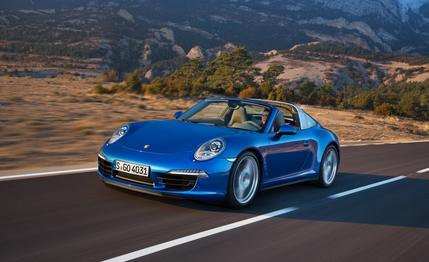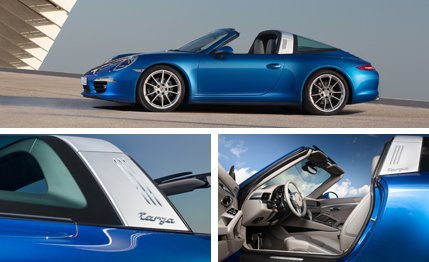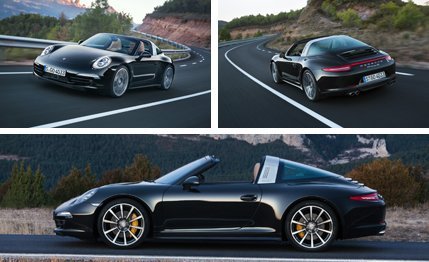
 First Drive Review
First Drive Review
The word “targa” has several meanings in Italian. It’s a tablet, a ceremonial shield or plaque, and also what Italians call their license plates. And most relevant to us, it’s in the name of Italy’s second-most-celebrated road race, the Targa Florio, which Porsche dominated in the 1960s before a rapidly rising body count finally ended it. When Porsche produced its first open-top 911 at the 1965 Frankfurt motor show, it bore the name Targa ostensibly as a tribute to the company’s Targa Florio victories but also, no doubt, because an Italian saying the word sounds like a cheetah growling: “TAR-grrr!” And Pontiac had already—perhaps criminally—pilfered the name Le Mans.
Outside Italy, Targa means first and foremost a Porsche 911 missing part of its roof. And “missing” is a key word here, because for three generations of 911 we’ve had Targa tops that were basically glorified sunroofs. In the 993, 996, and 997 models, giant glass panels slid back to let in Mother Nature while the side roof beams stayed in place. Targa, sorta.
Back to Basics in the Most Basic Way
Now that we’re on to the 991 generation, Porsche has decided to return largely to its original concept of a center cloth roof section that disappears completely, leaving a silvery roll hoop, complete with retro fish gills, to remain as the body’s dominant styling feature. The pricing lands a smidge under that of the 911 cabriolet, giving cab shoppers a tempting alternative.


In this new Targa, the roll hoop is conjoined with a rakishly fast piece of wraparound rear glass. The two elements together completely change the 911’s profile into something new. They give it a distinct Batmobile persona while preserving the coupe’s slipperiness, especially compared with the earliest Targas, which sacrificed the 911 coupe’s lovely tapered roofline for sharp vertical lines resembling the two halves of an open drawbridge. Compared with them, this new Targa looks far more voluptuous and exotic.
Another change: Robots do all the work. Pull the one button that lowers the roof out of the 18 kajillion buttons on the console (a separate button raises the roof), and a 19-second glockenspiel show—with motors, cams, pistons, pushrods, and spool reels—springs into action. The rear glass rises on stilts like an H.G. Wells Martian invader; a pair of flaps in the roll hoop flip up; long, spidery arms yank the roof through the channels revealed by the flaps and into a shallow bin behind the rear seats; and then the car reassembles itself.
For several reasons, you must be at full stop to drop. Those reasons include that the deployed rear glass protrudes more than a foot beyond the plane of the back bumper, obscuring the taillights and creating legal issues. Also, Porsche designed the mechanism for lightness, the trade-off being that it can’t handle any g-force while in mid-wiggle. And the deployed rear glass panel looks like a flying spinnaker. It weighs 79 pounds with its legs, has nearly invisible tungsten defrosting filaments sandwiched between its two glass layers, and is supplied by Glas Trösch, the same Swiss specialist that supplied the rear glazing of the Porsche 944. It would surely create a parachute effect were the car moving. But never mind. If you can’t find 19 seconds out of your day not to be in motion, then you are officially overscheduled.


Worth noting: Although the Targa’s rear park sensors have been reconfigured to sound the code-red alarm when an object is still 15.7 inches off the back bumper, or beyond the swing of the rear glass, it will not stop you from lowering the roof and accidentally bashing it into something behind you. Nor does the car know if you’ve left a wedding cake in the top’s storage compartment, which can double as behind-the-seats cargo space when the roof is up. So check your mirrors and your stuff—the Targa is not idiot-proof, only idiot-resistant.
Top Dropped—Now What?
Wind buffeting has long been another hobnob of the Targa concept, envisioned back in 1965 not for beauty or practicality but to meet expected rollover protection standards that didn’t come until much, much later. The buffeting remains on the new Targa, although Porsche has devoted many wind-tunnel hours to reducing it. One intervention is a simple two-position spoiler on the windshield header. The default lower position is the quietest, but there is still a faint hammer effect on the back of your head and shoulders at speed. Push the spoiler, and it springs up to a higher position, which dims the hammering more but at the expense of additional roar as air rushes under the piece. Kudos to Porsche for at least giving occupants the choice of how they’d like their wind served: heard or felt.